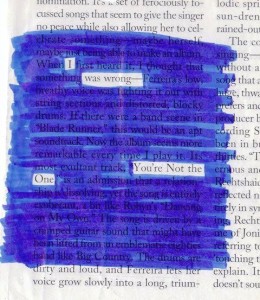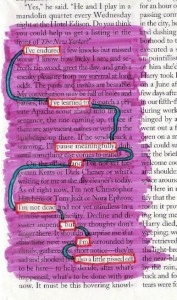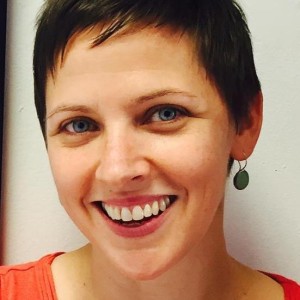Mary Akers: Hi, Laura. Thanks so much for agreeing to talk with me today. I am so grateful you let us feature your beautiful artwork in the January issue. I know this particular journey for you began with your “Love Redacted” series, which I adore, and which strikes me as being all about recovery. But I have also seen your work expand and evolve in wonderful ways, and I have to ask, how would YOU describe your work? Do you have an “elevator pitch” that you could give someone who has never seen it?
Laura Didyk: Hi Mary. Thank you so much for including my work. You are absolutely right about the Love Redacted series. I’m not sure recovery is the word I would have chosen back when I started—but it definitely fits now. If you look at my earliest redactions, like the blue one below, and then look at the most recent ones (a few of which you published), you can see a pre tty classic transformation from weakness to strength, from heaviness to joy and lightness.
tty classic transformation from weakness to strength, from heaviness to joy and lightness.
Heartbreak caused by “failed” romance—despite how much creative work is born from it the world over—still feels like fairly embarrassing subject matter (or at least a vulnerable one), especially in your forties. Unfortunately, I know the landscape and how much time it can take to recover. I also know I won’t die from it (even though there have been times in years past when I wanted to).
When I started showing people the redactions, the response, especially from women, was so overwhelming and gratifying. It wasn’t just creating the work that started to help me feel better but the potential it had to help others feel better (or inspired or encouraged).
There’s an amazing book (actually a few amazing books) by a professor of critical theory at the University of Toronto named Mari Ruti. In one of them, The Case for Falling in Love, she emphasizes that failed love (though she rejects the concept of failure when it comes to romance) always brings compensation—it might not come right away, and it might not come in the way that we’d hoped, but if we’re open, it always comes. My compensation from my last break up (god, please let it be my last) is the Love Redacted series, and, really, visual art in general.
Visual art was not even in my peripheral vision three years ago. I’m a writer. Period. Doing the redactions—which became addictive pretty quickly—led to more and more of them, and then eventually to my drawings, which is mostly what I’m doing now.
Elevator speech? I’m terrible with those (clearly). My current boyfriend, who seems to appreciate my verbosity, said I should never try and be concise, that he wants as many of my words as he can get (we really like him) and offered me this funny acronym for the word concise: creative oration not collapsible in size easily. I love this.
So, screw elevator speeches (unless of course I need to write one in order to get money from some government agency).
If I was allowed to be obtuse in my elevator speech, I might use more of Mari Ruti’s words: “If we truly respect the mystery of love, we won’t pledge allegiance to its permanence . . . we’ll pledge allegiance to our faithful efforts to stay open to its transformative energies.”
MA: Nice. I like that.And I’m very interested in process–descriptions of how we GET HERE really fascinate me. I love learning how both writers and artists arrive at what they consider to be a final form. What can you tell our readers about your process?
LD: This is a tough one. I guess if I had to be pinned down, I’d say that my process with visual art parallels generally my process with writing. I can sit down and think I know exactly what I’m going to make, and then am quickly humbled by my own arrogance and by my assumption that I can dominate the creative process.
Art is different than writing in that with drawing I use ink straight away. I don’t usually use pencil and erase and perfect and erase and perfect. I use a pen, and then anything that goes astray, or feels like a “mistake” or problem, I have to solve by transforming the image into something else or taking it in a new direction. I have an artist friend who says that making art is almost pure problem solving. And I tend to agree with that, but with an added dose of mystery and intuition.
MA: I know that in addition to your fine artwork, you are a wonderful writer. I’m wondering if you find that your writing and artwork inform or overlap one another in exciting and/or inspiring ways? And could you talk briefly about the joys and frustrations of the overlap?
LD: Thank you for the good words on my writing—that means a lot coming from you.
I don’t think that they overlap, no. Obviously, the redactions involve text, and I do feel like my love of language, and both my tendency toward the non-sequitur and my aversion to cliché in my own work, is part of an ingrained aesthetic that is certainly reflected in the Love Redacted series. (As a side note, I’ve seen other work in this same vein, but the result, in my opinion, outside the work of the true masters, is often overly familiar sentiment. It’s fun to find phrases and words and string them together to say something other than what the text is saying. That’s clever. But it’s another to pull language out that genuinely surprises and ignites something in the viewer, turns expectation on its head, creates pain or urgency or inspiration in the body. That’s art, if I may be so bold.)
I will say that people around me, for whatever reason, tend to really want my writing and art to overlap—not that thinking about me and my work keeps them up at night. It’s just they’ll ask if I’ve considered including illustrations in my memoir, or poetry in my drawings. Like I said, down the line, I might find myself doing this and have to eat this interview, but at the moment, the suggestion irritates me beyond measure (friends, are you reading this?), though I’m not exactly sure why—it’s probably something I should look at [insert smile].
MA: I’ve thought a lot about the function of art, the accessibility of art, and the conversation between artist and “consumer.” And I feel like art takes two. That the artist makes a thing (poem, sculpture, meal, song, whatever)–we could even call it an art widget–but at first it is simply the artist talking to him-or-her-self until there is someone on the other side of that art, enjoying it, experiencing it, or even hating it. But in a sense art takes two brains to be fully realized–the creator’s brain and the experiencer’s brain. What is your perspective on the idea of conversation being inherent in the creation/realization of art?
LD: Writing, making art, making anything solely for the self has value, of course. But I don’t feel like a piece of writing or art or music or choreography or whatever is truly living until it’s been received, seen, heard, experienced. This could mean publication or exhibition or sharing something across a table from a friend. Like I mentioned, when I started showing people the Love Redacted work, the pieces started to come alive and want more than just sitting in a plastic binder sleeve.
MA: And finally, since we are a recovery-themed journal, what does “recovery” mean to you?
LD: Transformation. We are so focused, as a culture, on happiness, getting it, becoming it, making happiness happen, that we don’t spend much time focusing on what the hell it actually means. Recovery, for me, has been about transforming from a person who had virtually no inner resources with which to deal with adversity and darkness (how do I deal with being heartbroken? Easy: drink, do drugs, find another love interest—hurry!) into a person who now has the emotional strength and mental stamina to deal with challenges that are going to come my way—loss, heartbreak, failure, rejection, et al—challenges that come everyone’s way. It’s been about doing everything I can to become a braver person.
Be brave. It’s a powerful directive. And one I take to heart. But you just can’t suddenly be brave. Sometimes we need help to do that. And I’m using the term help loosely as it can come in many forms. Just to say that, generally, we don’t “recover” from much by ourselves.

